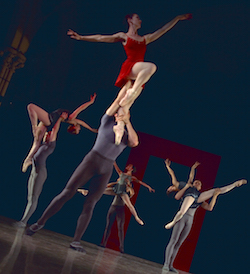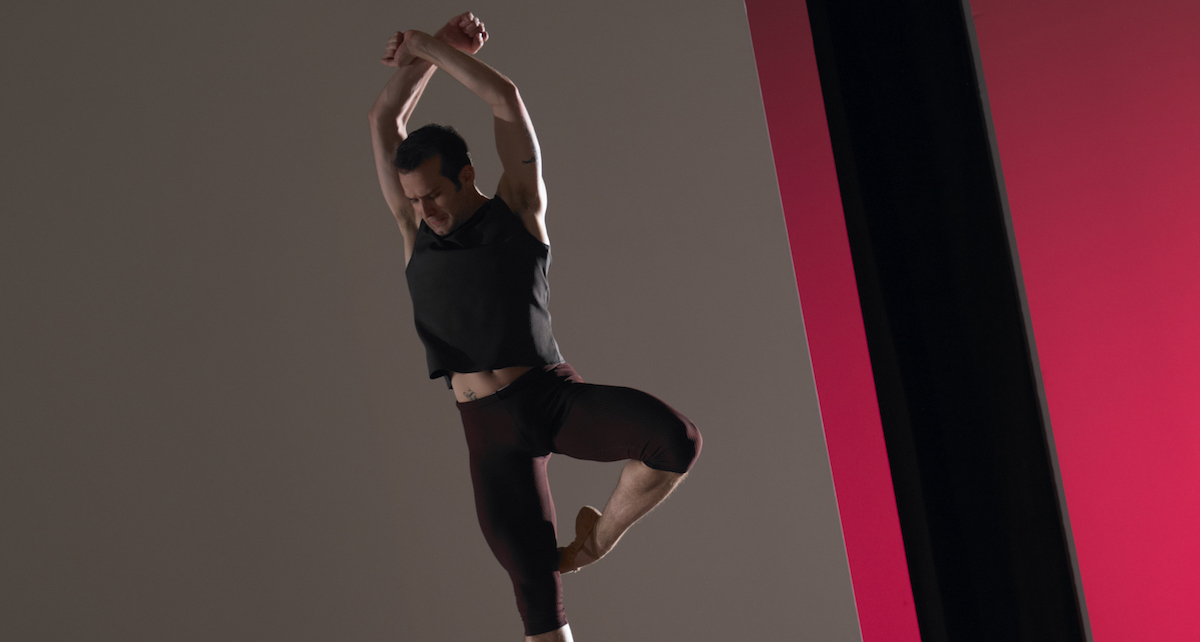The Sanctuary Theatre, Cambridge, Massachusetts.
March 31, 2017.
Artists are constantly navigating many balances. Among them are how much they surprise (and sometimes even shock) audiences, and how much they build cohesiveness and something familiar, something comforting. Too much of the former, and audiences may be too taken aback to support the artist and/or the art form again. Too much of the latter, and they can fall short of posing important questions and pushing the art form forward. In Taking Flight, José Mateo Ballet Theatre has struck that balance uniquely and skillfully.
The first work, The Last Circus, opens quite mysteriously. Dancers walk across upstage, pedestrian-like, in low lighting. The music is low and soft, yet with a menacing undertone. With a perhaps unexpected bang, the music, movement and lighting teleport to the exact other side of the energetic spectrum. Bright lights shine over dancers offering zippy allegro, to match the fast and driving music (score is Stravinsky’s Concerto for Piano and Wind Instruments). Bright costumes, such as one in lavender for a leading soloist, further energize the stage. Other costumes, such as red bodices and skirts of red and black pleats, allude to the circus of the title.

José Mateo Ballet Theatre. Photo by Gary Sloan.
A repeated phrase is a battement à la seconde into an échappé seconde, ending with an attitude croisé devant, with minor alterations at separate executions. Each dancer brings a unique quality to this phrase, and therein contributes intrigue to movement that has become familiar. Creative formation choices also add interest to sections of largely classical vocabulary.
A line of dancers travel through the formation of another, for instance, the spacing pleasantly clean and crisp. Those formations are also constantly changing, and dancers are often traveling on and off stage. This keeps the visual interest flowing, like the constant buzz of activity at the circus. Some of these changes could be a bit faster, however, as there are moments of bare stage. On the other hand, perhaps viewers appreciate the energetic rest.
In any case, jazz vocabulary elements – such as forced arches and layouts – offer sugar and spice. Partnered lifts reminisce those from forms such as disco and ice skating. The dancers, through varying tempos and energetic qualities, offer the movement with grace and style. The soloist in lavender, for instance, has incredibly supple and skillful footwork.
To end the piece, the dancers circle, and a figure in white – seemingly a clown – pops into its middle in a split (with a pop at the end of the music to match). The circus might be ending, but its mystery and joy can carry on. Sometimes we can’t know how until we experience it. That we can expect. And the surprise can be wonderful.
The second piece, Reverie, opens with energy and flair. Just as occurs later on in the first piece, skillful allegro compliments the speedy score (Maurice Ravel’s Piano Concerto in G [Movements 1 and 2]). Pastel-like blending of lights on the stage’s architectural backdrop add color to the black of some costumes (with others in contrastingly bright red). The stage offers an overall Balanchine-like Semi-Spartan aesthetic.
Spacial tension is palpable at certain points through smart formations and dancers’ strong use of gaze. The dancers also demonstrate their versatility, just as skillful at adagio sections later on. Épaulement and lifted lightness are fully there for the enjoying. In those slower sections are wonderfully fresh, creative partnering and formations. A truly picturesque moment, for instance, is a section of three pairs, the men in red tops and black bottoms and the women in black unitards. The choreography, spacing and visual elements come together to create something captivating.
Also memorable is a section of just two dancers on stage, the ballerina moving slowly and the ballerino dancing much more quickly, along with the music in crescendo. Viewers can feel the dramatic tension and perhaps imagine up scenarios between them. We can never truly know (short of the artist explaining to us his vision), but we can dream, along with the imaginative “reverie” of this work.
The third and final work, The Even and the Odd, brings a more Spartan feel yet. As with the two prior pieces (and thus by now familiar to audience members), lower energy evolves to higher before long. To open the piece, a dancer in the pose of Rhodin’s The Thinker becomes a statue-come-to-life. His pose bursts into allegro with the springiness of a cat on the hunt.
Just as with the two prior pieces, this one offers unconventional, and thus intriguing, partnering. It has elastic extensions and beautifully controlled attitudes. Shifting from that, waltzing circle formations fill the stage. At certain points, movement effectively parallels the music’s dramatic build, with tools like level changes and dancers moving at different speeds from one another.
A movement motif of a backward parallel walk, with one foot coming up to passé, builds a militaristic feel. Lines of dancers doing this walk begin to form. Are those joining the walk the “even”, and those not “the odd”? This theme is well blended with other groups continuing more classical vocabulary. Some mavericks join the drill-team stepping but then leave to dance again on their own and with others who dare not join the herd.
As with the second piece, we can imagine scenarios: from where this force of conformity came, what will happen to it and this group – that which it is shifting and shaping? We can expect not to know but still enjoy the surprises through the work’s twists and turns. Knowing can be comforting, but suspense can be a thrilling delight.
By Kathryn Boland of Dance Informa.















